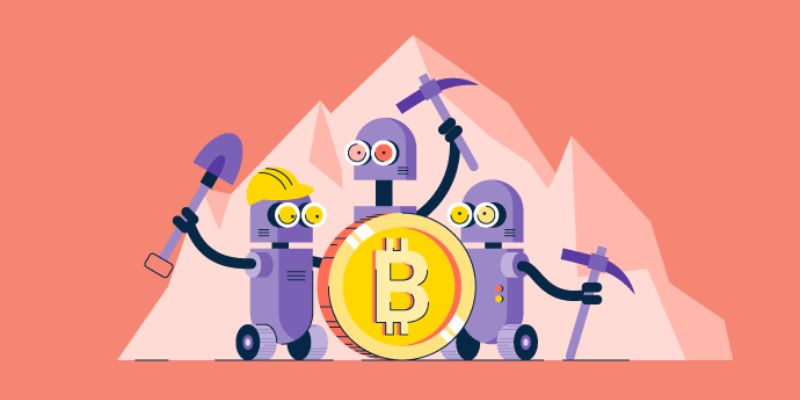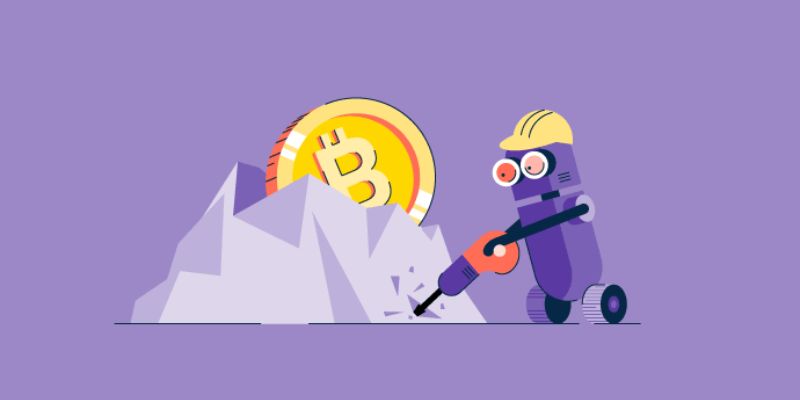How to join a crypto mining pool isn’t just about cashing in; it’s about joining forces with fellow miners to unearth digital riches. Picture this: your solo mining expedition, where rewards are as elusive as a mirage, versus the might of a mining pool, where collective efforts lead to consistent treasure. Knowing which pool to dive into can make or break your quest. Fear not! I’m here to guide you through the maze of pool selection, and show you how to claim your share of the pie with the wisest reward distribution strategy. Let’s crack the code together and turn those hidden mining gems into your sparkling reality!
Understanding the Basics of Crypto Mining Pools
Selecting a Mining Pool
Choosing the right mining pool is like picking a team for tug of war. You want a strong lineup but also folks you can trust. The mining pool’s size matters; bigger pools offer more frequent payouts, but the reward slice might be smaller. Smaller pools pay less often but might give you a bigger cut when they do. Look for a pool with a good rep and one that uses the mining protocol that fits your needs.
When you decide to join a Bitcoin mining group, check the pool fees. These fees eat into your profits, so aim for balance. Lower fees might tempt you, but higher fees can come with better services. It’s all about getting the most bang for your buck.
Also, consider the payout scheme. Some pools have a minimum payout threshold that needs a lot of mining work, which can be tough for smaller players. The location of the pool’s servers can affect your connection stability and, in turn, your potential earnings. The closer the server to you, the better.
Lastly, connectivity and security are crucial. A mining pool with top-notch security features will keep your hard-earned rewards safe.
By now you realize, selecting a mining pool takes a bit of thought, but it’s the foundation of your mining success. Use these points as a crypto mining pool guide, and you won’t go wrong.
The Essentials of Mining Pool Rewards Distribution
Rewards distribution is the bread and butter of pool mining setup. It’s all about how you and your fellow miners share the spoils. Different pools have different ways of slicing the pie, and this can impact your wallet. Pools may go by ‘Pay Per Share’ or ‘Proportional’ methods, or even fancier schemes like ‘Pay Per Last N Shares’.
‘Pay Per Share’ gives you a set rate for each share of the hashing work you submit. It’s like getting a steady paycheck. ‘Proportional’ systems pay you a slice of the block reward that matches the work you put in. And ‘Pay Per Last N Shares’ looks at your recent work more than your older stuff.
You have to weigh these methods against the mining pool fees. Even a pool with a fair reward system but high fees can end up less profitable than one with a different method and lower fees. It’s all about the take-home pay.
Pay attention to the pool’s payment method as well. Can you get your rewards in the coin you mined, or will they convert it to another coin? How does that fit into your strategy?
Finding the best mining pools in 2023 means doing homework to see who offers the deal that’s right for you. Pool miners’ fees, the reward system, payout threshold, and payment methods all shape your bottom line.
Remember, knowledge is power, and you’ve got to use that power to max out your mining earnings. So dig into the details of crypto pool rewards distribution before diving in. It will make all the difference in your mining journey.
Preparing to Join a Mining Pool
Mining Pool Signup Process
So, you’re set on mining with others and need to know how to join a crypto mining pool. Start by picking a mining pool that fits your needs. Look for crypto pool rewards distribution, pool miners’ fees, and overall reputation to ensure you’re making a solid choice.
To join a Bitcoin mining group or any crypto mining pool, follow these steps:
- Create an account on the pool’s website.
- Validate your account through your email.
- Set up your payment details.
- Make sure you understand the minimum payout.
- Know the pool’s payment methods.
These steps get you into the pool but there’s still more to do to start mining.
Configuring Your Miner for Pool Mining
Done signing up? Let’s set up your miner. You’ll need specific mining pool software compatible with your hardware. Then, configure it to point at your chosen pool’s server. The mining pool algorithms vary, so choose the right one. It must match what the pool uses.
To set up, follow this pool mining setup guide:
- Install the mining software.
- Open the miner configuration file.
- Enter the mining pool’s server data.
- Punch in your mining pool username.
- Add your worker name and password, if needed.
After these steps, your miner should be ready to roll!
Remember, each miner and pool might have different setup steps. Read up on your gear and pool guides to nail it. If you get stuck, look for a miner configuration tutorial from your pool’s support or community pages. It can be a huge help.
Once you’re set up, the mining software does most of the heavy lifting. All you do is check in to see how your mining goes. Your gear links to the pool, and together, you all mine for crypto. You’ll see your share of the earnings based on the pool’s rewards system.
The key is making sure your hardware works well with the software and the pool. And don’t forget to check that your internet connection is strong and stable. Net issues can mess with your mining.
Joining the right pool can mean more earnings and less fuss. Take your time and choose wisely. The best mining pools of 2023 offer transparency, consistent payouts, and good support.
Mining by yourself can be tough and less rewarding. When you group up, you up your chances of earning from crypto. Pool mining means teamwork, and when the pool scores, you do too.
So, get into a pool that values your hash rate contribution. Look for one with a good track record. The goal is to make your mining fun and profitable, without too many bumps along the way.
Connecting to the pool and setting up isn’t too hard. Stay patient and follow guides. If things don’t work right off, don’t stress. Sometimes there’s a bit of trial and error to get it just so. But when it all clicks, you’re in for an exciting mining adventure.
Maximizing Your Profits in a Mining Pool
Mining Pool Profitability Comparison
When you’re aiming to join a Bitcoin mining group or any crypto mining pool, it’s crucial to compare prospective pools for the potential profits. Profits can vary widely. The best way to start is to look at the pool’s size, payout structure, and what they charge. Bigger pools might offer more regular payouts, but the rewards are often smaller since you share with many miners. Smaller pools could have larger payouts, but they might not happen as often. Remember, regular small payments can match up to less frequent big ones over time.
Analyzing Pool Miners’ Fees and Shared Block Rewards
Let’s break down fees and rewards. Every mining pool has fees. These are part of the deal. They can range from low to high. Look for pools with lower fees. Lower fees mean more profit for you.
Shared block rewards need a good look too. When a pool finds a block, the reward gets split among miners. How much you get depends on your contributed hashing power.
Always check how a pool counts your work. This affects your share of the reward. The most common methods are Pay-Per-Share and Proportional. Pay-Per-Share gives you a set amount each time the pool finds a block, while Proportional divides the reward by how much work you did compared to everyone else.
Solo mining is an option, but joining a pool is often better. Solo miners find blocks less often. Pools have more power and find blocks more regularly, giving you steadier earnings.
To amp your profits, keep these tips in mind:
- Join a pool that aligns with your goals and values.
- Consider the location of the pool’s servers. Closer servers mean lower latency, which can improve your earnings.
- Check the minimum payout. A lower minimum payout means you can withdraw your crypto more often.
- Look at the payment methods. Pools may offer different ways to pay out your share. Pick what works best for you.
- Always validate a pool’s reputation before joining. Look for reviews and ask other miners for advice.
- If you’re into Ethereum pool mining or altcoin pools, the same rules apply. Though different coins might offer different rewards and have unique pool landscapes.
It’s about finding a balance that fits your mining setup and goals. Take your time researching because the right choice can lead to a more profitable experience.
So, as you explore the best mining pools 2023 has to offer, weigh their fees, payment methods, and reward systems against your needs. Armed with these insights, you’re ready to choose a pool that can boost your crypto mining revenue. Remember these gems of advice when you dive into the world of cryptocurrency mining collaboration.
Ensuring Security and Efficiency in Pool Mining
Mining Pool Security Features
When you join a Bitcoin mining group, security matters most. A good pool protects your rewards and personal data. Always select a pool with two-factor authentication (2FA); this will keep your account safe from hackers. Also, look for pools that offer secure, encrypted connections to protect data.
You want a pool with a solid track record for security. Reputable pools will display their security measures on their website. Read up on them before you join. Reach out to their support if you have questions about their security features. Your digital safety should be their priority.
Troubleshooting Connectivity Issues and Understanding Hash Rate Contribution
Ever have trouble getting online? When mining, this can stop you from earning. First, check if your internet and hardware are working right. A simple reboot of your gear can fix many issues. If problems last, contact your pool’s support team.
Now, about hash rate. Your hash rate is how much computer power you lend to the pool. More power means you have a bigger role in finding blocks. It also means you’ll get more rewards. To check your hash rate contribution, most pools have a dashboard. Look for the stats that show your current and past hash rate.
Remember, joining a pool is a balance. You need to look at fees, pool size, and the coin you want to mine. Small pools might find blocks less often but offer a larger cut when they hit. Big pools find blocks more often but may give you less per find. Think about what fits you best.
If you’re trying to get the hang of mining, many resources are available. There are complete tutorials and guides, like miner configuration tutorial, to help you get started and make the most of your mining efforts.
Configuring your setup can also be careful work. Make sure to follow every step. Missing a single detail can stop you from mining effectively. Always ensure your mining software is up to date. This will let you stay competitive and efficient within the pool.
In conclusion, pool mining needs careful thought on security and efficiency. Protect your earnings and personal info. Deal with tech troubles fast. Understand how much you contribute. This knowledge is power. The power to secure and boost your spot in the crypto world. Choose well, stay safe, and mine on!
In this post, we dug into crypto mining pools. We looked at how to choose one and how they share out rewards. Then, we covered signing up and setting up your mining rig. We compared profit points and looked at fees and shared rewards. Lastly, we touched on keeping your mining safe and fixing common issues.
I’ll leave you with this: mining in a pool can boost your crypto gains. Choose your pool wisely, thinking about profit, safety, and the tech side of things. Use what we talked about to get started and keep your mining on track. Happy mining!
Q&A :
What steps do I need to take to join a crypto mining pool?
Joining a crypto mining pool typically involves several steps. First, you’ll need to do your research and choose a mining pool that supports the cryptocurrency you are interested in mining and suits your needs in terms of fees, payout structures, and server locations. After selecting a pool, you will need to register an account with them, configure your mining hardware with the pool’s server address and your personal account information, and finally, start your mining software to begin contributing your computational power. Always ensure you follow the specific guidelines provided by your chosen mining pool for seamless integration.
What makes a crypto mining pool attractive to miners?
Several factors contribute to the attractiveness of a cryptocurrency mining pool. Miners often look for pools offering lower fees, which means a larger share of rewards goes to the miners. Reliable and consistent payout structures are also crucial, as miners want to know when and how they’ll receive their earnings. The pool’s hash rate plays a role in determining the frequency of finding blocks; pools with higher hash rates may find blocks more regularly, potentially leading to more stable earnings. Lastly, security features, user-friendly interfaces, and responsive customer support are key components that attract miners to a particular pool.
Are there different types of cryptocurrency mining pools?
Yes, cryptocurrency mining pools come in different types, each with unique features and payout systems. The most common types include Pay-Per-Share (PPS) pools, where miners receive a fixed amount per share submitted, regardless of when the pool finds a block. Proportional (PROP) pools divide the rewards in proportion to the number of shares submitted by each miner relative to the total number. There are also Score-Based pools that assign a score to each share during a round and pay according to the score at the end of the round, and Pay Per Last N Shares (PPLNS), which calculates payouts based on the last N shares, regardless of round boundaries. Each type has its advantages and is suited to different miner preferences.
How do mining pool fees affect my profitability when joining a pool?
Mining pool fees can significantly impact your overall earnings from mining. These fees are typically a percentage of the mining rewards that you earn while participating in the pool and are meant to cover the pool’s operating expenses and provide profit to the pool operators. Higher fees can eat into your mining returns, whereas lower fees allow you to keep a more substantial portion of the mining rewards. Therefore, it’s crucial to consider the balance between the reputation and reliability of a mining pool and its fee structure to ensure maximum profitability.
Can I switch between crypto mining pools, and if so, how?
Yes, miners are free to switch between crypto mining pools as they see fit. If you decide that a different pool is more suitable for your mining goals, you can switch by reconfiguring your mining software with the new pool’s details, such as the server address and your new account information. It’s essential to settle all accrued earnings with your current pool before leaving, as some pools may not pay out below a specific threshold. Always review the new pool’s terms and requirements thoroughly to ensure a smooth transition and continued mining success.



